5 Amazing Waterfalls of Havasupai
Planning a trip to Havasupai? Learn about the five amazing waterfalls of Havasu Canyon including where they are, tips for visiting, and more!
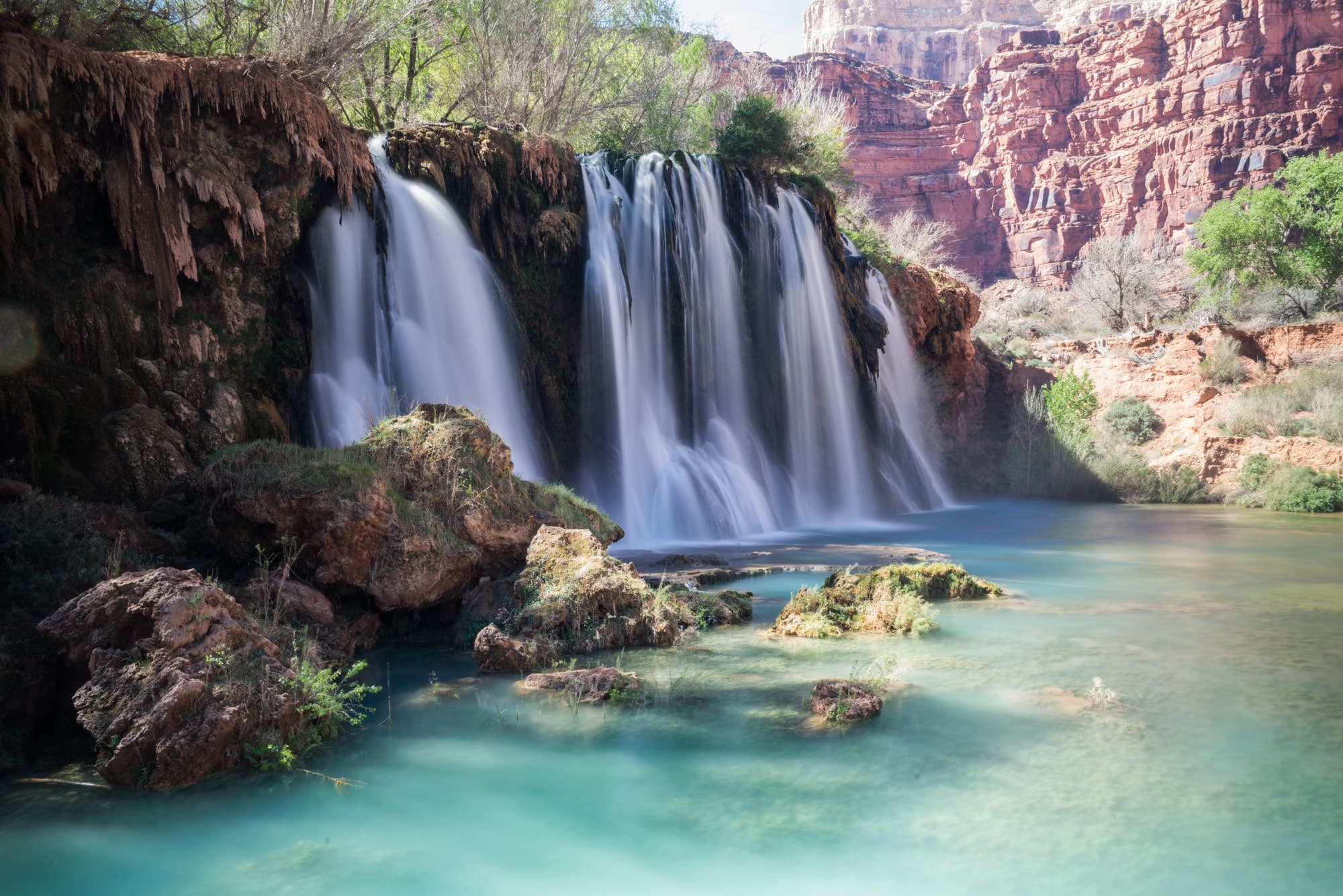
Havasu Canyon is home to the Havasupai Tribe of Arizona, whose name is translated to “people of the blue-green water.” If you’ve seen photos of the Havasupai waterfalls, it’s easy to understand how they got their name.
The creamy aquamarine, spring-fed Havasu Creek gets its exquisite color from heavy limestone deposits in the cliffs that line Havasu Canyon.
Most visitors who get a permit to Havasupai can’t wait to see the stunning Havasu Falls, but what they don’t realize is that there are actually several waterfalls in Havasu Canyon, all of which display that incredible teal color.
Both times I’ve visited Havasupai, it felt like I was transported to an otherwordly turquoise oasis that was magically placed in the middle of the desert. Honestly, this place seems to defy nature.
In this post, I give you the scoop on these 5 waterfalls of Havasu Canyon along with some of my favorite photos from my trips. If you want more info on the trail, camping, permits, directions, and other logistics, be sure to read my Havasu Falls Permit and Camping Guide.
This post may contain affiliate links.
Where are the Havasupai Waterfalls?
Havasu Canyon is located on the Havasupai Indian Reservation in Arizona. The canyon empties into the Colorado River in the Grand Canyon National Park.
The map below shows the location of the 5 waterfalls of Havasu Canyon. Three of the waterfalls (Havasu, Mooney, and Beaver) are located closest to the campground while Old Navajo Falls and Fifty-Foot Falls can be visited either on your hike into the campground or on your way back out.
Important: You cannot visit these waterfalls without a permit or as a day hike. You MUST obtain Havasupai Campground reservations before hiking to see these falls.

Save this post!
Enter your email & I'll send this post to your inbox! You'll also receive my weekly newsletter full of helpful advice for planning your adventures.
The 5 Waterfalls of Havasu Canyon
1. Fifty Foot Falls
Fifty Foot Falls is located about 8.5 miles from the Hualapai Hilltop Trailhead and a mile or so past Supai village.
On my first visit to Havasupai, I was tempted to keep going past Fifty Foot Falls. I thought we should find a nice campsite, set up our tent, and then go hang out at Havasu Falls – thinking that one was going to be the real treat.
The only thing that stopped us from continuing to the campground is that we were hot and tired from the hike and ready for a swim. Plus the river was insanely beautiful with tons of travertine pools where we could sit and hang out right in the middle of the river.
After passing through the village of Supai, we took a side trail down the hill that led to the river. Once you are down the hill, you’ll find a less obvious trail that will get you to the large pool below Fifty Foot Falls. The trails down to Fifty Foot Falls aren’t marked or obvious but keep trying side trails and you’ll find a way to the bottom of the falls.
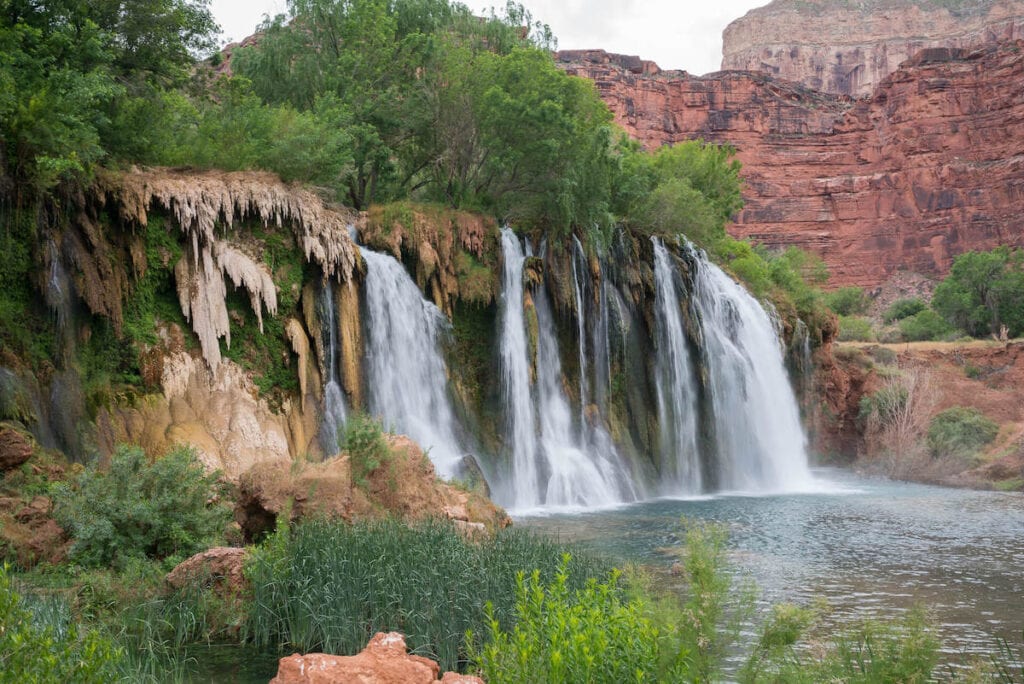
This waterfall and the cascades below it ended up being my favorite for swimming. The falls get plenty of afternoon sun and – at least when we were there – we had the pool all to ourselves!
The lesson is, Fifty Foot Falls is definitely worth a stop on your way to the campground. The two miles from Supai to the campground is downhill and once you get down there, you probably won’t want to make your way back up.
Alternatively, if you do really want to get to the campground early to get a good campsite, you can also visit Fifty Foot Falls on your hike back to the trailhead at the end of your stay.

2. Navajo Falls & Little Navajo Falls
Navajo Falls is directly below Fifty Foot Falls, but due to recent flooding, the falls look completely different than when I visited.
BFT team member Courtney backpacked Havasupai in 2023 and the former trail down to these falls is blocked off (part of a larger section of the trail that is blocked off) and there are signs to stay away from the ledge due to unstable ground. You can still see the cascading falls from behind the fence on the main trail, but she couldn’t find any side trails that led to the actual falls.

A note about monsoon season: Monsoon season in Arizona typically runs from mid-June through September. Havasu Canyon has historically seen flooding, including dangerous flash floods. Be prepared by checking the weather forecast, complying with rules and regulations, and checking in at the tourist office before you head into the canyon.
3. Havasu Falls
Havasu Falls is down the hill about three-quarters of a mile past Navajo Falls. The first time I visited Havasupai, I was worried that when I got to Havasu Falls, it wasn’t going to be as beautiful as the pictures I’d seen. That was definitely not the case! I was so happy to find that the falls are even more stunning in real life.
When you first approach Havasu Falls, the trail comes in from above on the left side. There are some great photo ops on the way down the hill, so make sure to stop and snap a few shots.

Once you get down to the bottom of Havasu Falls, hang a right down the side trail to get to the pool. There are several picnic tables where you can sit, have a snack, or stash your stuff while you go for a swim.
Beware of sneaky, food-snatching marmots, though, and make sure you don’t leave any tasty treats or loose gear out for them.

Havasu Falls is much more powerful than Fifty Foot and Najavo, but the pool is still totally swimmable. It does see shade in the afternoon, which could be good or bad depending on the time of year you visit.
For nighttime photography, Havasu Falls is your best bet. It’s the closest and easiest to get to from the campground in the dark. Plus the canyon walls aren’t so tall that you can’t get the night sky in your photos.
4. Mooney Falls
Mooney Falls is a short distance past the campground, but the trail to get down to the pools at the bottom is pretty sketchy by most people’s standards. I recommend wearing a small daypack for your stuff so your hands are free to help you down the steep, slick rocks, and ladders.
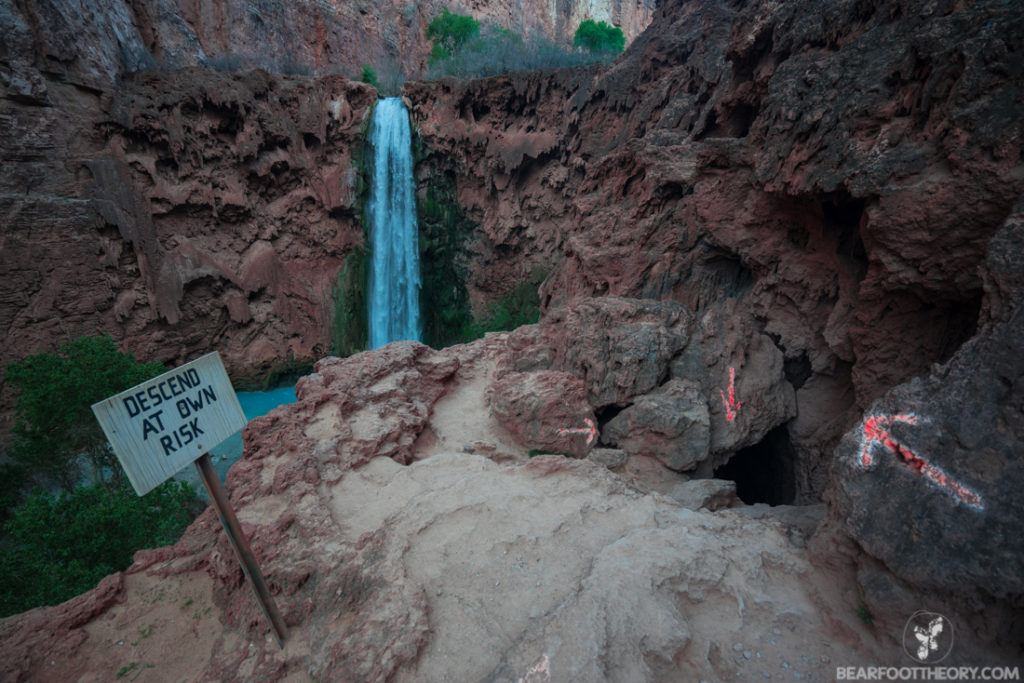
I’m not saying this to scare you, the trail down is totally doable, but it’s better if you know what you are in for. The good news is that the climb down is pretty short and doesn’t take more than 10-15 minutes. Once you are there, the canyon opens up for many more miles of river to explore.
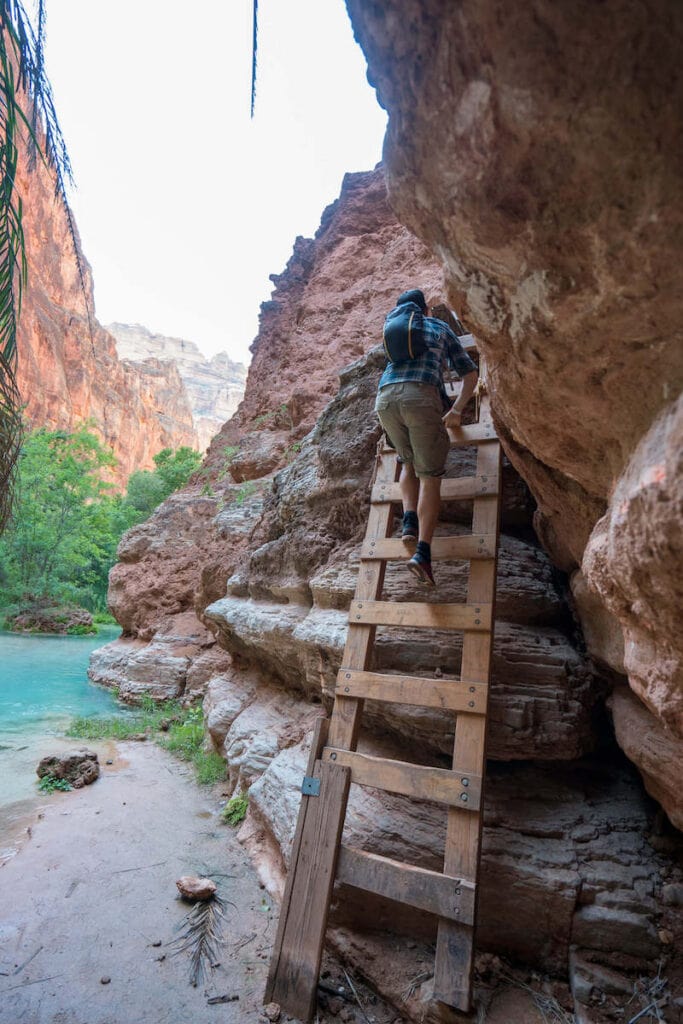
Mooney Falls is the tallest and most forceful of the 5 waterfalls of Havasu Canyon, and if you choose to swim in Mooney Falls get ready for some turbulence. The mist alone is enough to leave you pretty soaked!
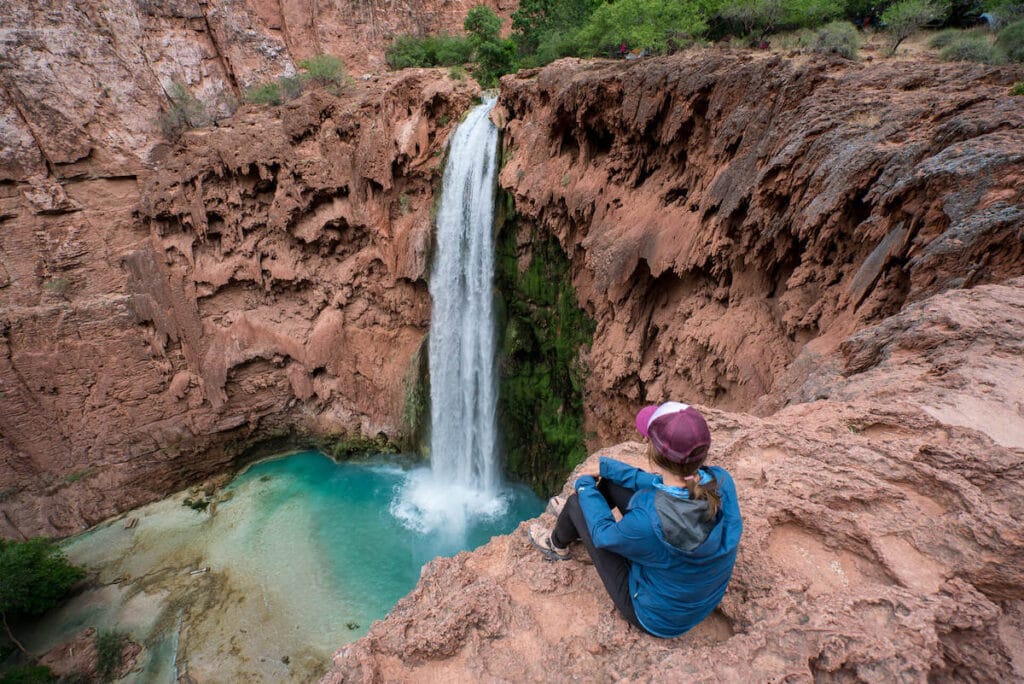
5. Beaver Falls
In terms of scenery, Beaver Falls was my favorite of the five Havasupai waterfalls. It’s deep down in the canyon about 2.5 miles past the campground. The trail to get there is dynamic, with ups and downs, river crossings, and amazing views.
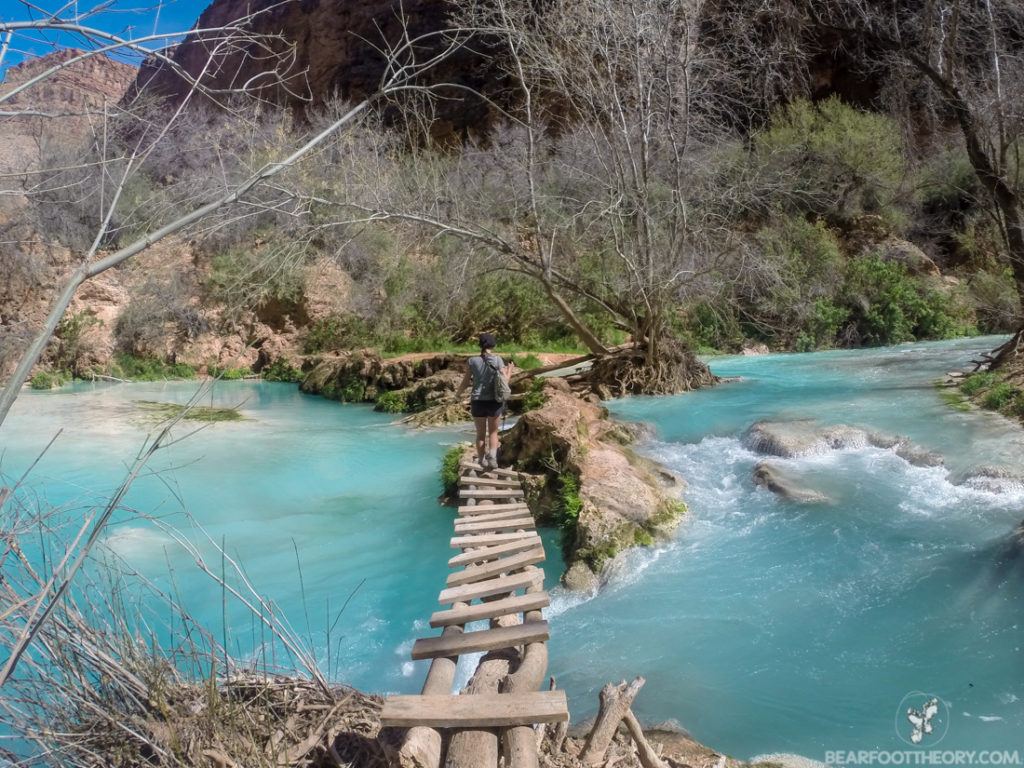
Before you walk down the hill to get to the falls, there is a small bluff with a picnic bench. I recommend stopping here to take some pictures. It’s also a great place to have lunch before or after your swim.
What was really cool about Beaver Falls was that you could walk up from one pool to the next and there is also a trail that runs up the left side. While some places were deep, a majority of the pools were shallow enough to wade in and you could sit right in the falls and let the water pour over you.
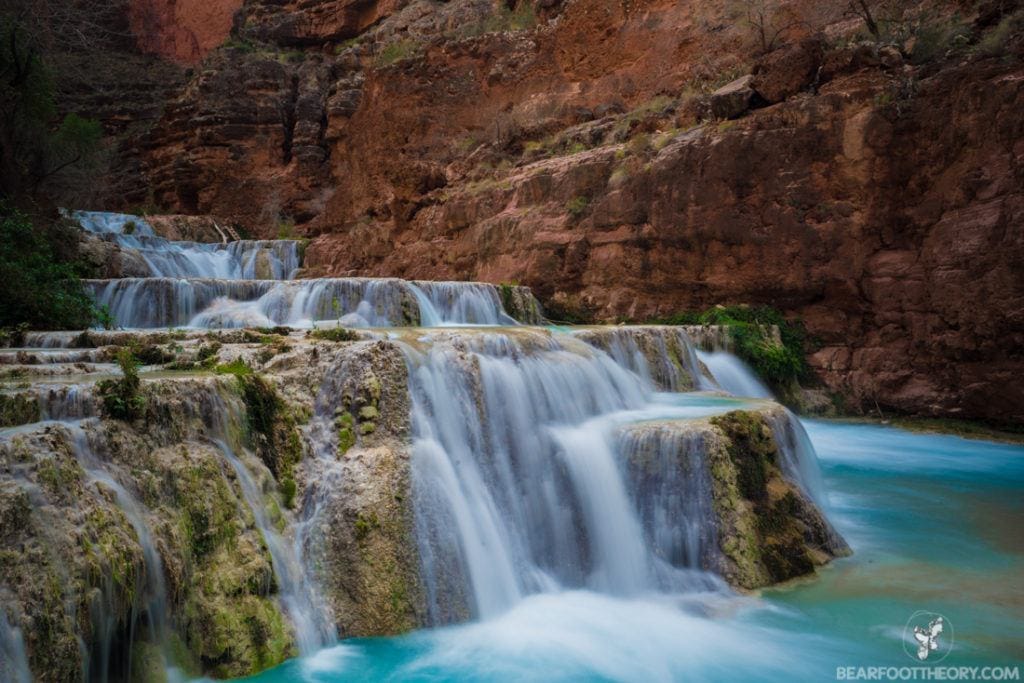
You should be aware that Beaver Falls (at least in March) was totally in the shade when we arrived. The canyon walls are steep and by the time we arrived in the early afternoon, the sun was long gone. Again, in summer, that’s probably a good thing, but just something to keep in mind, depending on the weather.
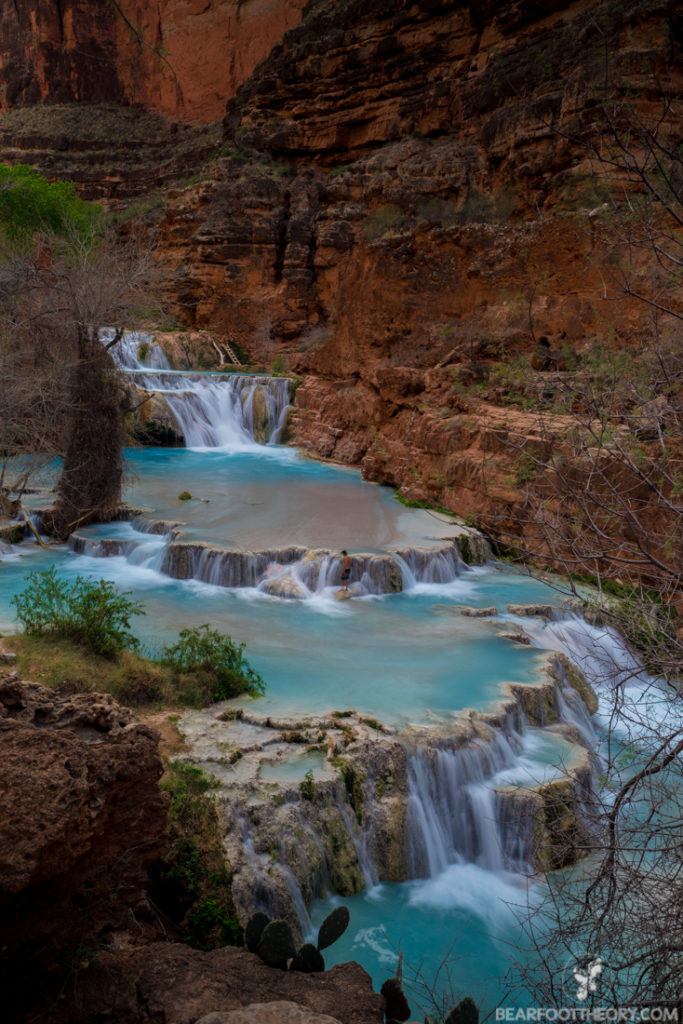
Best Time to Visit the Havasupai Waterfalls
The best time to go to Havasupai depends on what you’re hoping to see and do.
July and August are typically the busiest months to visit since many people are on summer break or vacation, and these months are also great for swimming. However, summer temps are HOT so be prepared to hike in/out in the dark to avoid the scorching heat.
If you’re looking for cooler, but still pleasant, temps, spring (March, April, and May) and fall (September, October, and November) are my favorite times to visit Havasupai. However, the water may not be too enjoyable for swimming when the temps are cooler.
Winter can also be a nice time to plan a trip, but be prepared with warmer clothes, especially if you intend on hiking to the different waterfalls.
Have you visited Havasu Falls? Which is your favorite Havasupai waterfall? Which one are you most excited to see in person? Leave a comment below!

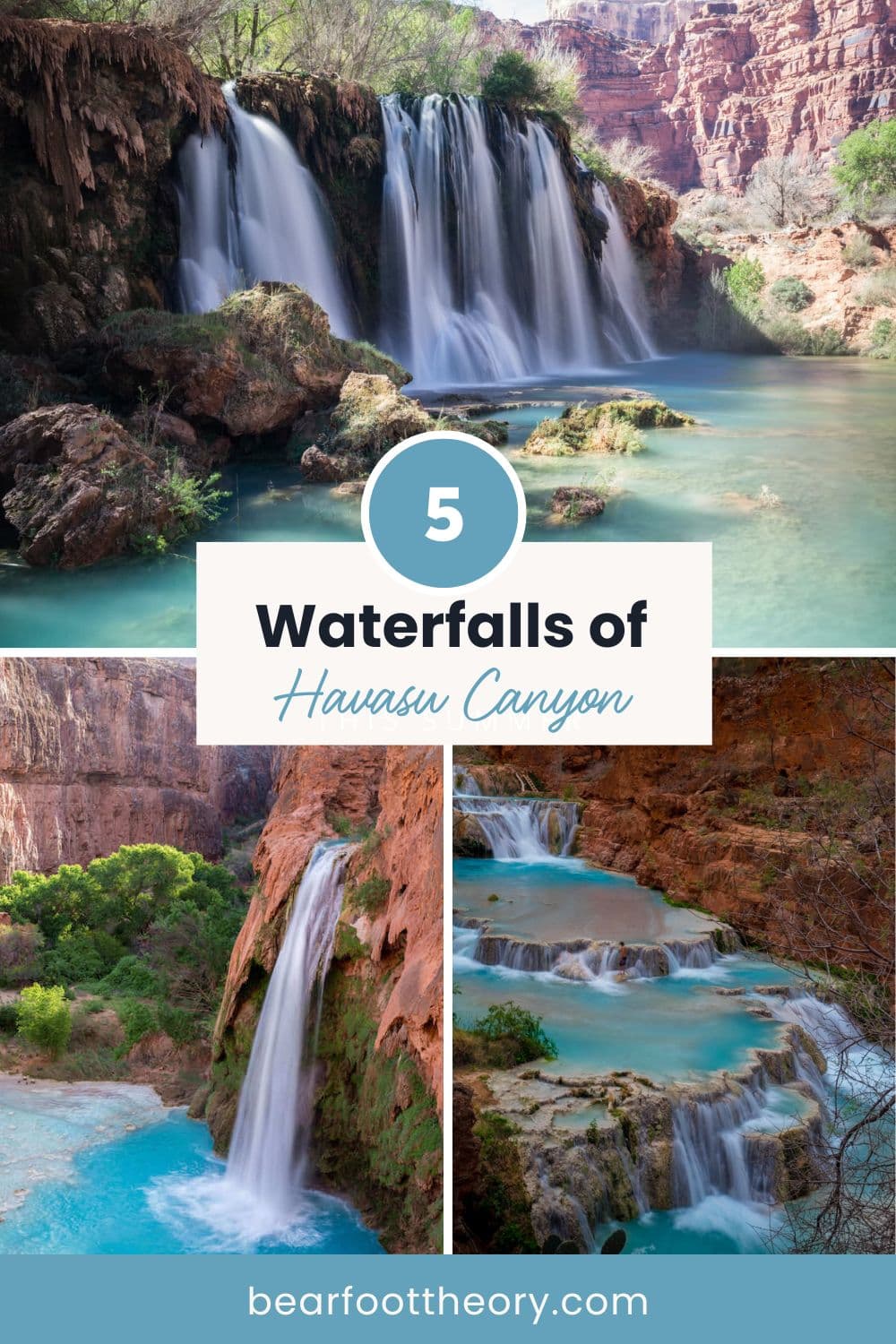
Great pictures! You are taking me back to 2007 when I did my first backpacking trip. Looking at my pictures, they were taken on an P&S and weren’t that good. Thanks for sharing! It is such a magical place.
I feel the same way about my old pictures. But I think that’s part of the fun…seeing the way your photos progress. The key to the photos on this trip was I brought a tripod and a variable density filter. It helped me be able to get those silky shots, even in the bright daylight. Thanks for commenting!
Great post Kristen! Really informative for first time visitors to Havasupai. Even with the internet research I did beforehand I really had no idea what we were in for. I’m still dreaming about our pretty little campsite next to the river. Looking forward to more adventures with you!
I agree with Angela: great shots! Follows well to your post about photography. 🙂 I am going to check out a variable density filter as well. Just returned from Nepal and this might have been helpful!
Was that mountain goat? Are they habituated from long-term exposure to hikers or you using a zoom?
Great tips!
That was a bighorn sheep, and I wasn’t using a zoom. We had just crossed the river and it came strolling down the trail and then crossed right in front of us. Didn’t seem to be bothered by us at all.
I love chasing waterfalls……. especially in the Philippines, where there are many. After a long trek to get there theres nothing better than to stand underneath and have a free water massage. Then a swim in the cool clear fresh waters.
I’ve heard beautiful things about the Philippines! Swimming in waterfalls there sounds amazing!
Kristen your pictures are beautiful. Thank you for posting. I am from Florida and like warmer weather. When is a good time for me to travel to the falls without freezing at night and its not to crowded.
I think April and May would be a good time or October.
My family was there in December or February. The falls were not frozen. Another time we hiked into the Grand Canyon just before Christmas on the S. Kaibab Trail. Conditionat the top: icy. Conditions at the bottom: warm weather like Phoenix, AZ in the wintertime. I don’t think these falls ever freeze. A LOT of springbreaker college students s visit Havasu in the spring months. Might be better to go in the winter like we did for peace and quiet.
Hi Pat, I think you’re confusing Lake Havasu City (“Havasu” to the college crowd) with Havasu Falls in this case. Lake Havasu City is on the Colorado River and home to huge flotillas of houseboat rentals in March and early April, whereas the inaccessibility and quiet of this place isn’t much of a draw for the majority of college kids… thankfully!
No doubt about it for Grand Canyon as well — Flagstaff temps at the top, Phoenix temps at the bottom. Shoulder months are always best for this reason.
A friend who lives in AZ and has camped and hiked the trek says Oct is too cold to enjoy the water. If you don’t want to swim – maybe there will be fewer people in Oct. but on reveling in waters.
Your photographs are AMAZING! For the one of you in the water, were you using a GoPro?
Hey Chanel – Thanks so much for the compliment. I attribute it to the rad Sony A7R camera I rented from LensRentals.com. But that one photo you are referring to was taken with a GoPro. Thanks for the comment! -Kristen
I love this post! I love that you broke it down and showed a map on the waterfall locations from the campground. Can’t wait to get there this weekend! Again, thank you for sharing your tips!
Thanks for the comment! I’m so glad you found it helpful. If you have any other questions, just let me know. Thanks and have a blast out there! -Kristen
Wow, these photos are amazing! I especially loved the view of Beaver Fall’s different pools. Also, the trail to Mooney Falls does look like quite a climb. The view at the bottom definitely seems worth the effort, though!
Thanks Jessica! The trail to Mooney Falls was definitely a bit tricky, but they have installed chains to help you as you make your way down. And Beaver Falls was just magical. Thanks for following along! -Kristen
I have to get Paul out to Havasu Canyon!
You don’t happen to know if dogs are allowed? I don’t think she could do the chains (and I’m certainly not carrying her around), but would it be possible to take Choppy otherwise?
hey Sarah – With the exception of services dogs, there are no dogs allowed at Havasu Falls. There are other places in the region like Paria Canyon where you can have dogs. I wrote a post on Paria here: https://bearfoottheory.com/paria-canyon-backpacking-photos/
Hi Kristen,
Thank you so much for sharing such detailed information and beautiful pics!
What days in March were you there? We are thinking of camping mid to late March and was wondering how cold it gets so we know what to pack. We live in FL so 40s might be extremely cold to us! Lol
Also, we are not experienced campers… Would you say the campground and conditions around it are suitable for 1st time campers? Would you recommend taking a hammock as well or sleeping bags? What is the inflatable bed you mentioned? We are staying 2 nights.
Also one more question… I’ve read there are helicopters out. Do you know how early you can book them once you’re there? From what I understand it’s a first come, first serve basis. I was just wondering if you had any additional tips on that.
Thank you again!
Hey Ana –
Congrats on getting into backpacking. It’s so fun and Havasu Falls is a great place to start. March will be chilly at night for sure. You’ll want to layer up with a down jacket and some wool long johns (that would be my choice), and you’ll need a warm sleeping bag and sleeping pad regardless of whether you sleep in a hammock or a tent. A hammock would be a great addition just to hang out in during the day as well.
have you seen these two posts on my site:
https://bearfoottheory.com/what-to-wear-hiking/
https://bearfoottheory.com/best-lightweight-backpacking-gear/
These are the kind of things you’ll want to bring and wear on your trip. The good news is the water stays the same temp year round so if you have a nice sunny day, you may be able to take a dip. Plus there will be less people in March.
I’m not sure about the helicopter. I would call the reservation number and inquire with them.
Cheers and let me know if you have any other questions.
Kristen
Please don’t take a helicopter there. We visited Havasu twice. The first time there was no evidence of helicopters. The second time as we approached Supai, the Havasupai village, after our 8-mile (I think, or I as it 6 miles?) a helicopter had just st landed there. It completely disrupted everything in the village. SO noisy! I know that helicopters are important for medical emergencies and food supply for the Havasupai people, but I would like tourists to slow down, do a day hike there or ride a horse if available. I think you probably could arrange to pay for a pack animal to haul most of your gear and just carry a lighter day pack down to Supai village. Once there you would probably need to carry your camping gear to the camp grounds belong the village (or maybe the pack animal would go to the campground (depends on steepness of elevations. Another option: By the 2nd time we visited a month tel had been built by the Havasupais in their village of Supai. On our 2nd visit with our elementary school-aged kids we made reservations and stayed at the motel. You can day hike to all the falls from the motel in Supai except to Beaver Falls, which might require staying overnights in a campground beyond and below Supai. Advantage of motel: You don’t have to carry a bunch of camping gear. The disadvantage: We didn’t like the food at the restaurant in Supai (deep-fried bread, a traditional Native American food). Better to pack in your own food so you can choose what you like. Packing in food for a few days plus water, and lunch for your day hike is a lot less weight to carry than hauling tents and sleeping bags yourself. We don’t know if f there are grills available to use the motel in Supai. You could eat food that doesn’t require cooking (PB&J sandwiches, bread, cheese, dry salami, sardines, fruits, including dried fruits). A few items can be purchased at the Supai grocery store (milk for cereal(, but the selection of foods is limited due to the remoteness of the area and limited choices made by the food ordered there. Mostly heavily processed foods. Maybe they have become more health-conscious since we were there in the 80’s. (Ancient, aren’t we?). If you purchase a small JetBoil backpacking stove with small propane canisters to take with you, tou wouldn’t need a grill for cooking. A small pot comes with the JetBoil. You could cook oatmeal, instant coffee, and hot chocolate for breakfast and a box of Kraft macaroni and cheese (with butter and liquid or powdered milk added from grocery store) for dinner. We like to add tuna (canned or in those flat packets) to our Kraft macaroni and cheese when camping for my more protein and for texture. Good luck! These falls are well worth visiting. Stunning scenery. Take $ with you to pay the Havasupais a fee for entering their Reservation. I assume they would still charge this fee. (Why would they stop doing that)? It’s a perfectly reasonable fee., a usage fee. Do your research first to learn the amount of this fee and other details associated with this trip. Be smart and take cash. Don’t expect them to accept plastic for payments even though they may accept it now. Learn about the Havasupai people and their very special homeland before you go there. Have fun on your adventure!
Hi there! I’m planning a trip to Havasupai this upcoming spring and was looking into getting a sleeping pad. I was glad to see you mention that it can double as a floatie! Are you able to use all inflatable sleeping pads in the water? And which one were you using in your pictures? Also, do you have any tips or insight for how you washed your camp kitchen items or if there are any areas to shower/bathe? Thanks so much!
Hi! Some float, some don’t. The thicker ones are the ones that are more likely to float. I know the Thermarest NEO Air and some of Big Agnes pads float.
There are no areas to shower or bathe (but there are toliets) and you shouldn’t use any kind of soap in the water. Check out this post on Leave No Trace and how to do dishes in the backcountry:
https://bearfoottheory.com/basic-guidelines-of-leave-no-trace/
I would really like to go hiking here but am not interested in camping. Do i still still to get a permit?
Day hiking isn’t allowed and a permit is required for all hikers.
These pictures are making me so excited for a trip there! Do you think it would be to hot to hike the first week of May? I have had such a hard time trying to get them to answer their always busy phones. I hope I can get a reservation.Thanks Deidre
I think the temps in the first part of may will be ideal.
Hi there! We are going to the Grand Canyon for 10 days in May! I am calling daily trying to get a reservation. The gentleman I spoke with tonight said just to keep trying especially closer to time; people cancel reservations alot of times. We only have two days available at the end of the trip to be able to do this. I am a active runner….and my husband goes elk hunting in the Colorado mountains yearly. Would it be possible to do this trip in the two days? Also how far of a drive would it be from Peach Springs AZ to the Hilltop. My in laws will be dropping us off and picking us up! Thank you for all of your great advice. I am praying someone cancels for the night we need!
You can definitely do it in two days (but you’ll probably miss the sidehike to Beaver Falls). According to googlemaps it’s about 1 hour 45 minutes from peach springs to the parking lot. Hope you get the permit!
Were you ever able to get a campsite booked? Right now I am in the same boat, I am calling every day but they just say, “Booked through the end of the year” They didn’t even let me ask a date. Did this happen for you as well? Thank you!!
You really make me want to go again. Went there in 1991 at the age of 12 and had the run of the place with other 6th graders in the club. I’m sure rules have changed and what not now but I am determined to get my family down there this year. And your pics are soo much better than the ones I have…gotta love technology.
Hey! Probably a lot busier than 1991, but still magical. Have fun with your family down there and thanks for stopping by my website!
I am considering taking our kids, ages 10 and 13. However, I am worried that there are too many opportunities for curious kids to slip over an edge. Thoughts?
The trail is wide and well-maintained except for the section down to Mooney Falls.
What are your thoughts on staying in the lodge in Supai and then doing day hikes to the falls?
I haven’t stayed at the lodge so I can’t say…but if you camp you will be much closer and I think it’s a nicer setting than the lodge.
Hi, thank you for this wonderful description of the falls. I just got back from a three day adventure in the canyon. I was able to hike to all 5 waterfalls. I stayed at the lodge, and I agree with you, it would have been better to camp because of easier access to the falls. it added an extra 4 miles a day that could have been time spent playing and swimming. The weather was absolutely perfect and the water was so refreshing. It was not crowded at all. The campground looked to be about 1/3 full. The climb out of Mooney Falls was one of the scariest and most rewarding things I have ever done.
Hello!
Thank you for this awesome post. My two friends and I are thinking of hiking here, we were just wondering if you think its possible to complete this entire trial in one day? I dont think we have time to stay overnight here. If not the whole trail how far do you think we can get in a day?!
Also, do you need a permit for staying for the day?
Thanks so mcuh!
They don’t allow day hiking and you need a permit…the falls are at the very end so even if you tried to do it in a day, it would be a 20 mile day, and you have to pay the full camping fees.
I found this to be so helpful, thank you for sharing your wonderful experiences and all the helpful notations of info! I do have one question, though. Would you happen to know what the min and max capacity is for a campsite? I\\\’m looking and can\\\’t find it anywhere…
2 queries ?
Camping rentals – All necessary things will be available to rent, right ? Including life jacket, portable chairs and the floater. Please advice.
2. Food – Any suggestion, recommendation would be helpful.
Thanks a lot for your time.
Hi Kristen,
Great site. I am planning to go there in mid March. could you tell me the settings you use on your camera to get the silky waterfall effect?
we were planning to use mule/horses to bring our camp gear up the hill but some member in our group kept reading about animal abuse on sites, did you happen to see any of that? also are the any latrine near the campground. many thanks.
You’ll need a tripod. Then you need to slow the shutter speed down and adjust the other setting accordingly. The shutter speed will probably be somewhere in the 1/5 second or less range…but play around to get the look you like. The horses did not look like they were in good shape when we were there. I recommend packing your bag out if you can. And remember it will be lighter on the way out since you’ll have eaten all of your food.
We are planning a summer 2018 family trip to Grand Canyon. Our kids will be 13, 16, and 18.
We are interested in a 3 or 4 day guided backpacking tour. Can you please recommend a tour company? Would you suggest Havasu Falls or Phantom Ranch as destination? Thank you for any guidance you can give me:)
I’m leading a trip with Arizona Outback Adventures in May in Zion. I haven’t done their Grand Canyon trips, but they come highly reviewed. I haven’t been to Phantom Ranch so I can’t really recommend one over the other. I’m sure you can’t go wrong with either.
Hello- I found your blog through the interview you did with Matt at Superstar Blogging. I am so glad to find your site since In a few years I will be an empty nester and want to travel the parks in the western US. The Grand Canyon is on the top of my bucket list- can\\\\\\\\\\\\\\\’t believe I turn 50 this year and still have not been there! Now I will want to pair this with my trip to Grand Canyon. You did an awesome job on your photography- I am inspired to go!
Awesome April! Thanks so much for getting in touch. Definitely makes sense to combine Havasu falls with the Grand Canyon. have fun out there!
Hello! Are you familiar with Stand Up Paddle Boarding near Havasu falls? I have seen pictures of this, but can’t figure out where to do this? Maybe this is closer to Grand Canyon? What is the difference between Havasu Creek and Havasu Falls? It is a little hard to distinguish online. Thanks!
I believe those people hiked their SUPs in and did it on the creek somewhere below the falls. I haven’t seen it in person, so I’m not 100% sure.
Hello!
I’m in Havasupai at the end of April – I’ve done enough research and enough solo travel, but for some reason I’m being a bit of a wuss about this one. Not sure why. So … here’s what is going to provide me with comfort.
As a solo traveller … is the trailhead well marked from the Hualapai Hilltop car park to the village? Like really well marked or am I going to get lost and get eaten by a mountain lion? Were there quite a lot of people doing the same thing when you went or were you just trekking on your own? Looking at pictures it seems that the trail is sometimes not as well marked on dusty routes.
The trail follows the wash, so if you just follow that down, there really isn’t any way to get lost. There weren’t a ton of people when I was there, but we did pass the occasional person. Good luck! Hope you have a blast!
Hi Kristen,
I had a question about the Beaver Falls. I heard that it is difficult to find. Is this accurate? I don’t want to pursue this hike next week in the case I may get lost. Do you have any advice on the trail and directions on getting to Beaver Falls? There isn’t much online about directions and how to get there.
Beaver Falls is not difficult to find. You just follow the trail along the creek below Mooney Falls and eventually you will get to it.
We are going this weekend! So pumped! Did you pack your own food or was there food you could buy inside the campground?? Thanks in advance!
You can buy food in the village, but I’d highly recommend preparing in advance and bringing your own.
Check out these posts with info on backpacking food:
https://bearfoottheory.com/the-best-good-to-go-meals-for-backpacking/
https://bearfoottheory.com/backpacking-food-ideas/
Hi, Found your information very helpful.. Im planning to go there on summer of this year. I wanna see how beautiful is the havasu falls.. Just have some question it would be my first time to hike there, do I have to camp in each falls.? If not should I go back to the campground then start hike the next day.?
Thank you
You camp in the campground and do day hikes to each of the falls, returning to the campground at the end of each day.
Hello !! Thank you for all tips !!!
We tried to book the Lodge or the Campground for June 2018 since September 2017!!!
So hard and we never had a permit…
A lot of people say than there is lot of place and than Indian people lie to protect their area.
Do you really think we are taking a big risk if we go down without a license? and we pay on the spot?
Thank you so much to answer us…we are really sad to have no license since the time we try to book !!!
Alan
Thank you very much for all your tips.
Please tell me if it is possible to book once on site without being rejected because we try for months without success. In addition, their new website, which can be booked from the 1st of February, was already full on the 1st of February until December. Which is technically impossible in a few hours …
I think to book by letter if not explaining my case. I will try it …
Tell me if you met people who have booked once there please.
These pictures are so beautiful. My husband and i are in our 60’s and do nit hike ir climb. Iwe are taking a road trip frim texas to California and woul live to stop and swim in the falls. Is there a way to di this?
Hi Cynthia, you have to have a permit for hiking to the falls and they are sold out as of now.
I love your blog and this post is so helpful! I am going in March and I’m SO excited! Did you hike to the confluence, too? I’m wondering if 2 nights and 3 days is enough time! Thanks!
I’ve hiked down to Supai before and after the flood of 2008 and man what a difference! Navajo falls used to be enormous with multiole jumping spots and a rock formation with water shooting out through a hole that you could try and put your arm into. Above Navajo used to be a natural shower where the water trickled down the moss onto your head. It was amazing. After 2008 flood we went back and it was totally dried out. It was one of the saddest days to see the difderence. But i was able to see 50 foot falls when it was fresh and there wasn’t a pool to swim in yet. It was super rocky. The waterfall you could walk behind was a fun change though. Diving through the water into the pool was a fun experience. Also, next time you go back, at beaver falls, there is what is known as a green room. You give down 3 feet and back like 4 feet and pop up in an underwater cavern that makes everything look green. It’s awesome! Thanks for this post. It took me back through memory lane and now is like to go back!
Thanks Kristen! Such an informative post ! Love it can’t wait to explore the falls this weekend!!
What a great blog post with fabulous photos! I have a question: in the section on Beaver Falls, you say, ” there may or may not be a Havasupai Ranger at the top. If there is one there, it’s just to make sure that anyone who is there paid the fee at the office in the village (more on that later).” I can’t find the “more on that later” part about the fees! Where is that? Thanks!
Hi Leslie, you can find more about the Havasu fees on our original Havasu post: https://bearfoottheory.com/havasu-falls-camping-guide/
Love your write up on the 5 different falls. Very helpful. I am going at the end of this month, April 2019. Can’t wait. Thanks for the helpful information.
I made three trips to Havasu Canyon (1965-1969)…back in the “good old days” when the climb down Mooney Falls involved iron spikes driven into the rock-face, chains for hand support, a few rickety ladders, and lots of prayer. Your great description of the hike stopped too soon, however. Continuing down to the juncture of Havasu Creek and the Colorado River is worth the hike. ..passageways through solid rock and the blue water of Havasu blending with the brown water of the Colorado…very striking images.
Thanks! I’m planning on doing that this year when I’ll be down there in October.
Kristen – Considering the 7 day full cyn motorized rafting trip from Lees ferry to Whitmore wash. Have you done this? Do you have a rafting co to recommend? Are there any SLOT CYN waterfalls (besides those you’ve listed here), that can be hiked into while on the full cyn float? I’ve seen pictures of super secluded slot cyn type falls, with STEEP 90 degree rock walls surrounding them in the past. Thank you for this site and your helpful info! Kevin
Hi Kevin – sorry for the delay in getting back to you. Kristen has not done the trip you’re referring to although I’ve heard about it and have always wanted to do it! Unfortunately, we don’t have any specific recommendations other than what’s in this blog post. Thank you for reading!
Great blog! I’m curious, do you have any photos of the elusive Green Room?
Thanks Mike! We dont have any photos of that.
What about this fee for Beaver Falls? I don’t see anywhere here an information about it. Could You explain? I never heard about it.
Beaver Falls is on the Havasupai Reservation, so you will be able to visit it with your Havasupai Permit. You can read more about getting a permit in this post